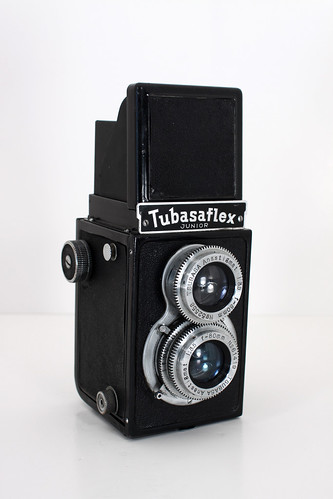Tsubasaflex

|
| Tubasaflex Junior image by Jason Hull (Image rights) |
The Tsubasaflex or Tubasaflex[1] is a Japanese 6×6 TLR made in 1951 by the company Kigawa Kōgaku.[2]
It is a simple TLR with a boxy shape and geared lenses for focusing. It is equipped with a loupe and a synchronized shutter. There is an advance knob on the right hand side, and a red window in the back near the bottom, protected by a vertically sliding cover. It is said that the Tsubasaflex is a copy of the Ricohflex IIIB[3].
It is advertised in March 1951[4] with a Tsubasa 80/3.5 coated lens and T, B, 25, 50, 100, 150 shutter speeds. The name plate is black with a thick chrome frame and Tsubasaflex written in lowercase chrome letters.
In advertisements dated May[5] and June[6], the name plate is now written Tubasaflex in lowercase and JUNIOR in small uppercase letters, and the surrounding chrome frame is finer. The lens is still a 80/3.5 but no name is given. Three variants of the Tubasaflex Junior are offered:
- Model I with T, B, 25–150 speeds;
- Model II with B, 10–200 speeds;
- Model III with B, 1–200 speeds and self-timer.
This page at Japan Family Camera (archived) and McKeown both present a Model I, and a page at Oozusi's former Ricohflex website presents a Model II. In the three cases, the lens is called Tsubasa Anastigmat.
In an advertisement dated November[7], some changes are visible. A button has appeared on the right hand side plate, it is probably the body release that is mentioned by the advertisement. The strap lugs are different. There is a decorative metal plate covering nearly all the front of the body, shaped to look like a movable (focusing) front plate. The name plate is now all metal with TUBASAFLEX written in uppercase black letters, and the JUNIOR marking has disappeared. Two versions of the Tubasaflex are offered, both with a Bessel 75/3.5 coated lens:
- Model I with B, 10–200 speeds;
- Model II with B, 1–200 speeds and self-timer.
Model I units have been observed in an online auctions with with Bessel 75/3.5[8] and with Tsubasa Anastigmat 80mm f:3.5.
Some version of the Tubasaflex has also been reported with a lens named Lause.
This camera is succeeded in 1952 by the Graceflex.
Notes
- ↑ These are merely alternative romanizations of the katakana ツバサフレックス. To the ears of English speakers the name starts with a "ts" rather than a simple "t" sound.
- ↑ Kanno, p.116, claims that some Tsubasa brand TLRs were manufactured after the company was renamed Carl.
- ↑ According to Japan Family Camera and Oozusi's website (see the links).
- ↑ Advertisement for the Tsubasa Semi I, II and Tsubasaflex, published in the March 1951 issue of Ars Camera, reproduced in Kokusan kamera no rekishi, item 608.
- ↑ Advertisement for the Tsubasa Semi I, II, III and Tubasaflex Junior I, II, III, published in the May 1951 issue of Photo Art, reproduced in Kokusan kamera no rekishi, item 608.
- ↑ Advertisement for the Tsubasa Semi I, II, III and Tsubasaflex Junior I, II, III, published in the June 1951 issue of Photo Art, reproduced in Kokusan kamera no rekishi, item 607.
- ↑ Advertisement for the Tsubasa Semi I, II and Tubasaflex I, II, published in the November 1951 issue of Ars Camera, reproduced in Kokusan kamera no rekishi, item 607 and item 608.
- ↑ Yahoo auctions Japan, October 2012
Bibliography
- Asahi Camera (アサヒカメラ) editorial staff. Shōwa 10–40nen kōkoku ni miru kokusan kamera no rekishi (昭和10–40年広告にみる国産カメラの歴史, Japanese camera history as seen in advertisements, 1935–1965). Tokyo: Asahi Shinbunsha, 1994. ISBN 4-02-330312-7. Items 606–8.
- Kanno Tsunetoshi (管野経敏). "A kara Z no kokusan niganrefu" (AからZの国産二眼レフ, Japanese TLRs from A to Z). In Miryoku saihakken: Nigan refu: Firumu kamera ha e no messēji (魅力再発見・二眼レフ:フィルムカメラ派へのメッセージ, Fascination rediscovery: TLRs: A message to film cameras). Tokyo: Shashinkogyo Syuppansha, 2006.
- Lewis, Gordon, ed. The History of the Japanese Camera. Rochester, N.Y.: George Eastman House, International Museum of Photography & Film, 1991. ISBN 0-935398-17-1 (paper), 0-935398-16-3 (hard). P.75 (brief mention only).
Links
In English:
In Japanese:
- Tubasaflex Junior (archived) and specs table (archived) at Japan Family Camera
- Tubasaflex II at TLR Milestone
- Tubasaflex II at Ishigaki's camera site